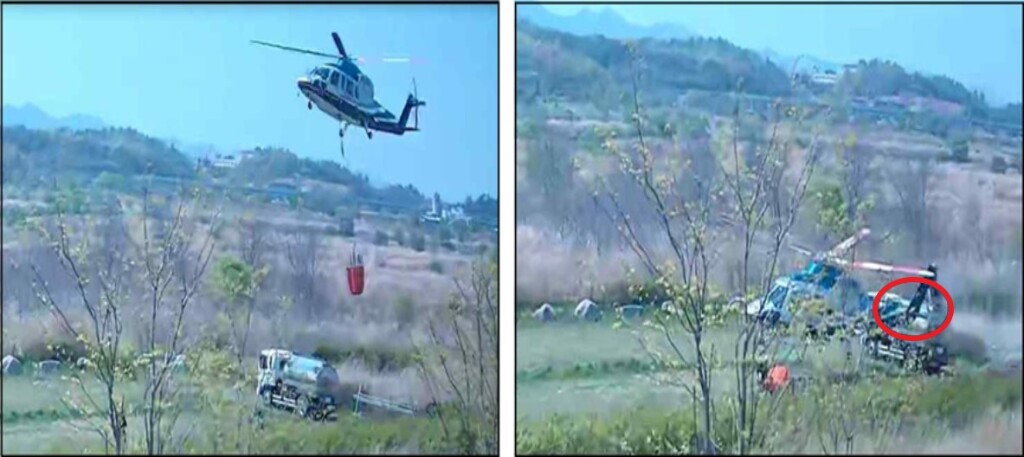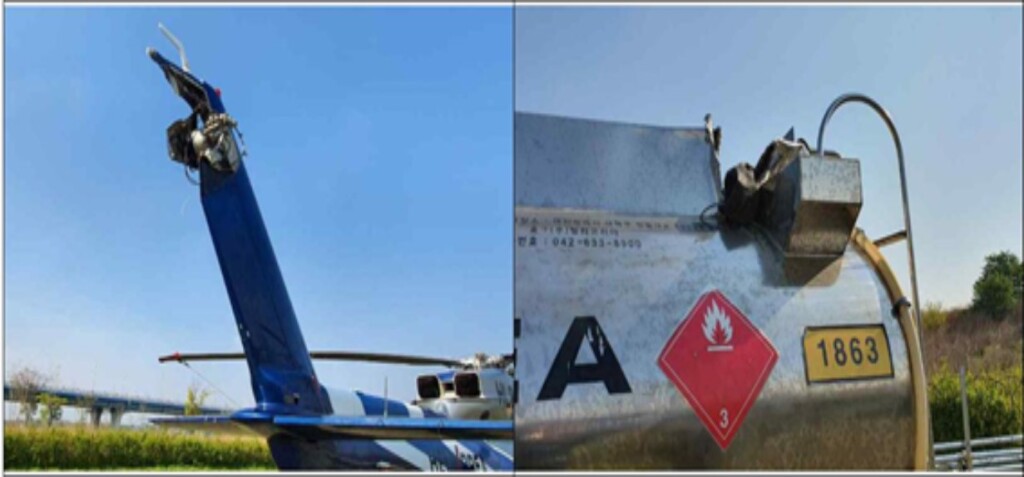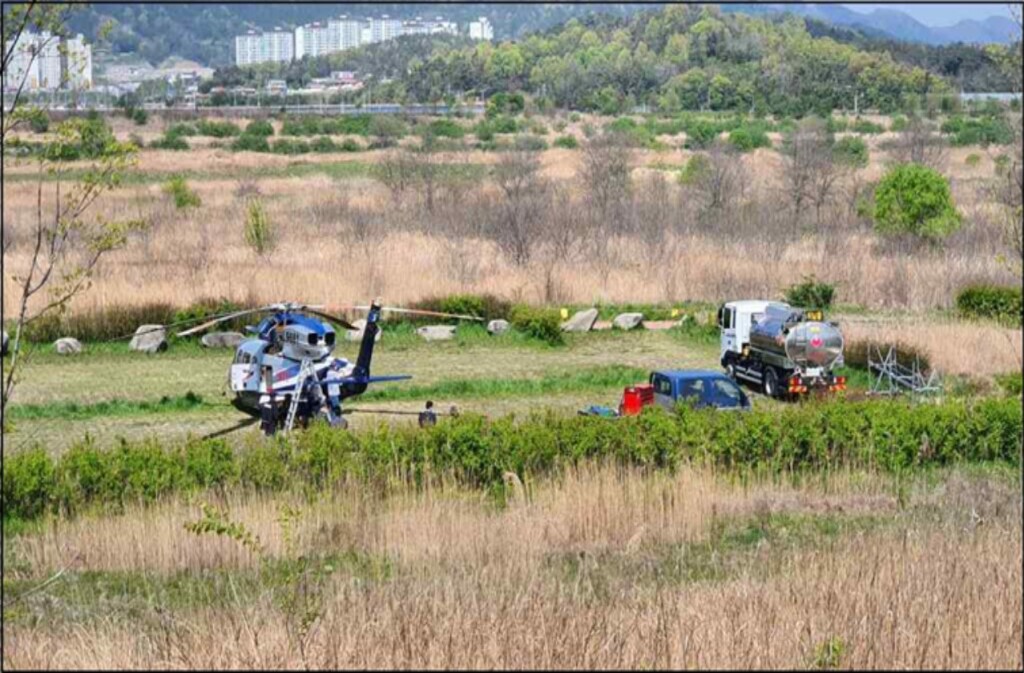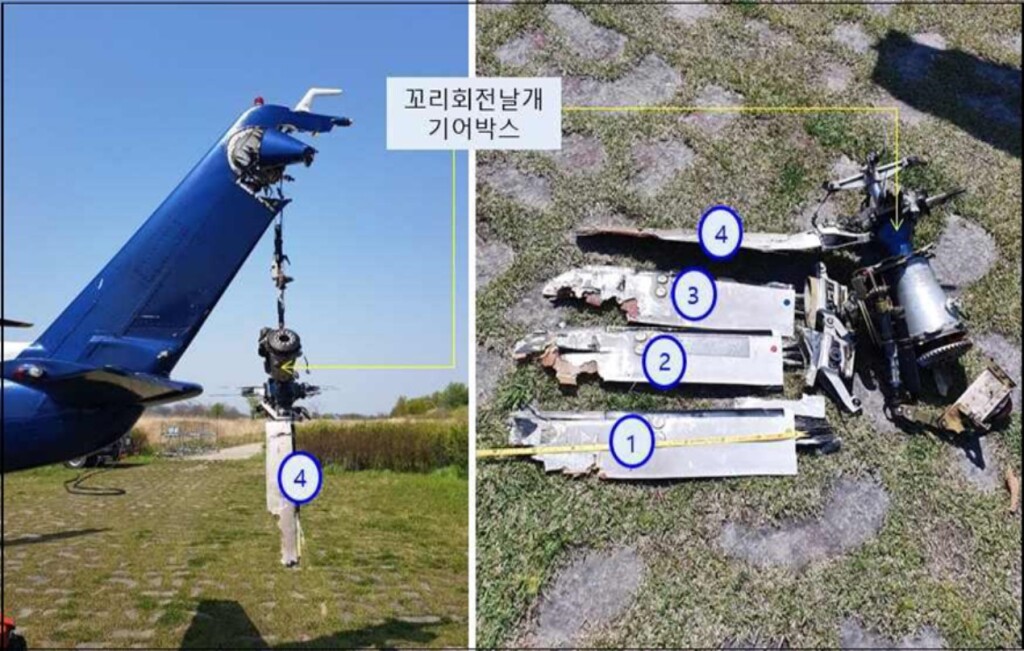South Korean Fire-Fighting Helicopter Tail Rotor Strike on Fuel Bowser (Heli Korea Sikorsky S-76C+ HL9661)
On 25 April 2020, fire-fighting Sikorsky S-76C+ HL9661 of Heli Korea suffered a tail rotor strike on a fuel bowser landed at a forward operating base at the edge of the Yeongsan River, South Korea. There were no casualties of loss of containment of fuel but the helicopter received substantial damage. The Korean Aviation and Railway Accident Investigation Board (ARAIB) safety investigation report was published on 29 June 2021 (in Korean only).

Approach of Heli Korea Sikorsky S-76C+ HL9661 to Landing Site & Tail Rotor Strike on Bowser (Credit via ARAIB)
The Accident Flight
The flight crew of two had been on duty since 08:30 at the forward operating base. One licenced aircraft engineer and a fuel bowser driver were also on site. The pilots had gone for lunch at 11:35, but they were called out at 11:52 to tackle a mountain forest fire. The helicopter took off at 12:12 and was on scene at 12:25.
After an hour of fire-fighting with an underslung fire-fighting bucket the crew decided to return for fuel. At the operating base, the wind was 35 knots gusting 45. Due to the wind direction the approach was in the opposite direct to normal. The helicopter flew over the fuel bowser and placed the fire-fighting bucket on the ground next to the engineer and bowser driver.
The accident investigators then suggest the wind caused the helicopter to drift backwards, although it seems reasonable to expect that after placing the bucket on the ground the helicopter would manoeuvre aft to land with the bucket and sling ahead of the nose. What is known is that the aircraft commander “felt the aircraft’s nose turning to the right with a thump and quickly lowered the collective”.
The tail rotor had in fact contacted the upper deck of the bowser.
The helicopter rotated 450° before coming to rest.
Fragments of broken tail rotors were widely scattered around the site.
The ARAIB Safety Investigation
There is no mention of any flight data recorder data being available. The investigators note that in Heli Korea’s procedures:
There was no information about the parking location of the feeling vehicle [and] here was no information about the [aircraft] parking position when a refuelling vehicle, which is fundamentally important for operational safety, was waiting for refuelling.
The investigator state the co-pilot should advise the aircraft commander of obstacles, and mention the importance of Crew Resource Management (CRM) but then say rather harshly in this case “it is judged that there was no active action or advice” by the co-pilot. They also complain of the weeds growing on landing site.
However, matters not discussed in the accident report:
- The approach briefing
- The decision to pass over the bowser rather than an offset approach and crab sideways
- Communications with the ground crew before or during the approach
- The positioning of the ground crew (which may have influence where the bucket was laid down)
- A recent prior accident involving the operator: On 18 March 202o Heli Korea Bell 214B1 HL9171 crashed into trees in strong winds during firefighting. with one fatality
- Another accident that occurred prior to the report being published: On 21 April 2021 Heli Korea S-76C+ HL9285 crashed into a lake during firefighting. with one fatality
ARAIB Conclusions
The cause of the accident was landing in strong winds, and unable to maintain position the helicopter was pushed backwards, and the tail rotor impacted the top of the rear end of the fuel bowser.
Contributing factors:
- A refuelling vehicle was parked close to the helicopter landing site.
- Landing procedures were not clear.
- There was no proper communication between the pilots about the helicopter going backwards.
Safety Resources
The European Safety Promotion Network Rotorcraft (ESPN-R) has a helicopter safety discussion group on LinkedIn. You may also find these Aerossurance articles of interest:
- Korean Kamov Ka-32T Fire-Fighting Water Impact and Underwater Egress Fatal Accident
- Firefighting AW139 Loss of Control and Tree Impact
- Ditching after Blade Strike During HESLO from a Ship
- Competitive Behaviour’ and a Fire-Fighting Aircraft Stall
- Short Sling Stings Speedy Squirrel: Tail Rotor Strike Fire-Fighting in Réunion
- Wayward Window: Fatal Loss of a Fire-Fighting Helicopter in NZ
- Helicopter Tail Rotor Strike from Firefighting Bucket
- Maintenance Issues in Fire-Fighting S-61A Accident
- Load Lost Due to Misrigged Under Slung Load Control Cable
- Firefighting Helicopter Wire Strike
- Fire-Fighting AS350 Hydraulics Accident: Dormant Miswiring
- Beware Last Minute Changes in Plan
- NZ Firefighting AS350 Accident: Weaknesses in Role Equipment Design and Distribution of Key Operating Data
- Unballasted Sling Stings Speedy Squirrel
- Emergency S-76D Landing Due to Fumes
- Ambulance / Air Ambulance Collision
- SAR AW101 Roll-Over: Entry Into Service Involved “Persistently Elevated and Confusing Operational Risk”
- UPDATE 30 October 2021: RLC B407 Reverses into Sister Ship at GOM Heliport
- UPDATE 23 December 2021: Air Methods AS350B3 Air Ambulance Tucson Tail Strike
- UPDATE 2 April 2022: Investigation into Collision of Truck with Police Helicopter
- UPDATE 14 August 2022: Second Time Unlucky: Fatal Greek Wirestrike High-Wire Illusion
- UPDATE 22 April 2023: Swinging Snorkel Sikorsky Smash: Structural Stress Slip-up
And




Recent Comments